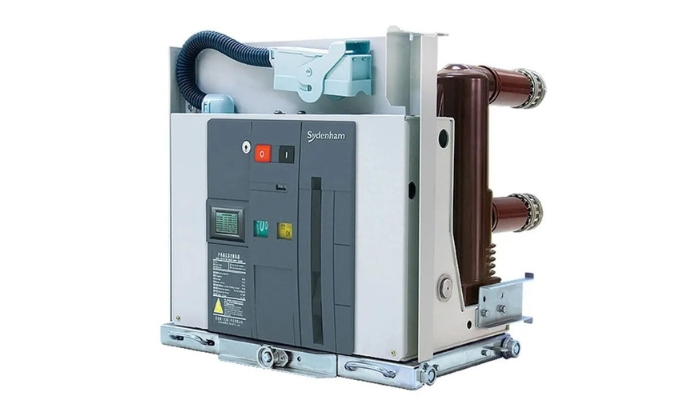What is a vacuum circuit breaker?
Due to its arc extinguishing medium and insulation medium of contact gap after arc extinguishing in a high vacuum condition, so it is called vacuum circuit breaker.
It has small size, light weight, and is suitable for frequency conversion
The advantages of a vacuum breaker, it has simple operation and arc extinguishing without maintenance, so it is widely used in electrical distribution networks.
Vacuum circuit breakers are indoor distribution devices in a 3~40.5kV, 50 or 60Hz three-phase AC system.
It can be used as electrical equipment protection for industrial and mining enterprises, power plants, and electrical substations etc; Used for protection and control, especially suitable for oil free, less maintenance, and frequent operation requirements.
The vacuum circuit breaker can also be configured in a central cabinet, a double-layer cabinet, and a fixed location for use; Used in the electrical switchgear for controlling and protecting high-voltage electrical equipment.
We did have over 20 years manufacturing in these circuit breakers, including this vacuum circuit breaker, custom design & fabrication for your electrical distribution networks or your electrical switchgear or integrated electrical substations etc.
Next, we will share some common faults of Vacuum Circuit Breaker and its solutions
In daily operation of these vacuum breakers, some common faults will be occured; in this post, we will discuss about these common faults and its solutions.
1.The motor does not rotate.
After discovering such faults, cut off all the power supply of primary and secondary circuits of the vacuum circuit breaker, and use a multimeter to measure the normally closed contacts WK1 and WK2 of the microswitch in the energy storage electrical circuit. If the direct resistance is large, it will cause the voltage at both ends of the energy storage motor to be too low until there is no voltage, making the motor unable to rotate. Therefore, it should be cleaned or replaced ; Then measure the direct resistance of the motor winding. If the direct resistance is abnormal, consider whether the lead wire of the motor winding is soldered off and whether the motor winding is burnt out. In emergency situations, the energy storage motor spare parts can be replaced first, and then the replaced motor can be repaired. If it is a DC motor, the contact between the carbon brush and the commutator should also be checked. If the contact is poor, the carbon brush should be replaced, or the carbon brush clamping spring should be adjusted to increase the clamping force of the carbon brush.
2. closing failure of vacuum circuit breaker
1. Check if the normally open contacts of microswitch WK3, anti jump relay ZLC, auxiliary switch HK, and interlocking limit switch WK8 in the closing control circuit are in good contact. If there is a poor contact phenomenon, it will cause the coil of the closing electromagnet HQ to have no voltage or low voltage, causing the disconnector to refuse to close. Therefore, it should be cleaned or replaced.
2. Check the closing electromagnet. If the closing electromagnet is burnt, detached, or jammed, it will directly cause the circuit breaker closing mechanism to not operate. The processing method is as follows:
(1) Use a multimeter to measure the direct resistance of the closing solenoid coil. If the direct resistance deviates too much from the normal value, the closing solenoid should be replaced;
(2) Check if the closing electromagnet is loose or detached, and tighten it if it is loose or detached;
(3) Check if the moving iron core of the closing electromagnet is stuck. If it is, remove the closing electromagnet, extract the moving iron core, wipe the dirt inside the electromagnet and on the moving iron core with alcohol, and then check if the end of the moving iron core is bent. If it is bent, correct it or replace it with a new closing electromagnet.
(4) Check the surface of the closing roller and closing switch for cracks and unevenness, as well as for jamming and eccentricity when the closing roller rotates. If the above defects exist, it will increase the friction force when the closing roller and the closing switch detach. In addition, the closing roller or closing switch can also cause rotation difficulties due to reasons such as lack of oil or dust difficulty, all of these may cause the closing electromagnet to be energized and the circuit breaker to refuse to close. Treatment method: Clean and refuel the parts that get stuck during rotation; Replace components that are eccentric or have cracks or bumps on the surface during rotation.
3. Refusal to trip
Check the opening electromagnet. If the opening electromagnet gets stuck, falls off, or burns out, it will directly cause the circuit breaker opening mechanism to not operate. The processing method is as follows:
(1) Use a multimeter to measure the direct resistance of the opening solenoid coil. If it is burnt out, replace the opening solenoid;
(2) Check for looseness and detachment of the opening electromagnet, and tighten its fixing screws;
(3) Check if the moving iron core of the opening electromagnet is stuck. If it is, remove the opening electromagnet, extract the moving iron core, and use alcohol to clean the dirt inside the electromagnet and on the moving iron core. If the end of the moving iron core is bent, correct it or replace it with a new opening electromagnet.
4. The direct resistance of the conductive circuit exceeds the standard condition
When the DC resistance of the conductive circuit exceeds the standard, the contact surface on the upper part of the vacuum bubble should be checked first, as there is only one fixed bolt between it and the upper outlet end, and the vibration generated during operation can easily cause the bolt to loosen. If the direct resistance still exceeds the standard after tightening the fixing bolts on the upper part of the vacuum bubble, the fixing screws of the conductive clip should be checked and the tighten it. If it exceeds the standard condiction again, it should be suspected that the contact surface between the contact arm and the upper and lower outlet terminals is oxidized. At this time, the contact arm can be removed, the oxide layer can be removed with metallographic sandpaper, and can be re tightened.
In daily operation of these vacuum circuit braker, it still has some other faults happening from time to time; if you still have any questions about our vacuum circuit breaker, please feel free to let us know.
